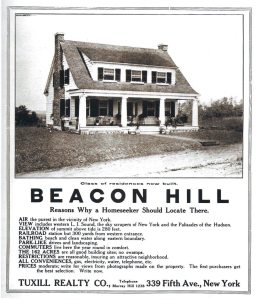
The recently published Gardens of Eden: Long Island’s Early Twentieth-Century Planned Communities, details the history of planned “residential parks” across Long Island, including Beacon Hill. The book covers the development of more than 20 remarkable communities and the colorful tales in their histories, compiled chapter by chapter by knowledgeable historians, an endeavor eight years in the making. Gardens of Eden was edited by the Society for the Preservation of Long Island Antiquities (SPLIA)’s former director, Dr. Robert B. MacKay.
Former Port-resident Lynn Stowell Pearson wrote the chapter on Beacon Hill, subtitled “A Gem in the Diadem.” Pearson worked for SPLIA for many years and previously held a variety of positions there, including public affairs official and guest curator. She became involved in the book in 2008 and began a long process of research, looking for as many original records as she could find. “Port Washington Library was fabulous with all sorts of sources,” Pearson said.She continued, “The Beacon Hill Residents Association had the foresight to save all of the minutes from their meetings and early lists of residents. They are all housed in the library and that was just a gold mine for me.”
In addition to research at the library, Pearson spoke to a number of residents. “What’s unusual about Beacon Hill, many of the residents lived there for decades,” she said. “They have a real tie to it and an understanding of the history.”

Pearson worked closely with Margaret and Arman Dildilian, who were helpful and generous with their time. They were the second owners of the house at 50 Crescent Rd. and obtained the original architectural plans for the Tudor revival from the first owners.
“The original owner was a guy named Arthur Keevil, who was vice president of U.S. Mortgage and Trust in New York City,” Pearson explained. “He bought the property in 1914, and then in 1925, he hired a NYC firm to design the house.” The house is pictured in the book. It still has the original casement windows installed.
Beacon Hill has maintained the original design and style, whereas many other communities have torn down houses and remodeled many with additions that don’t work with the house. “There’s an awful lot of integrity in Beacon Hill today,” Pearson said. “Not every lot, but more so than most of any of the other early developments on Long Island.”
Fun fact: Beacon Hill gets its name from Revolutionary War times, when fire beacons were set up on the hill as warning signals. “The name has been in use for many, many years.”
—Lynn Stowell Pearson
Some of the earliest homes can be found at 23 Crescent Rd., built in 1914, and 32 Summit Rd., built in 1913 by Frederick Franke, sales manager for Tuxill Realty, a major developer of Beacon Hill.
Early in the 20th century, word began to spread that Port Washington was a great place to live. “I did the same thing that everyone who moved to Port Washington in early 1900s did,” Pearson said. “We were in New York City and wanted to move for the kids, for the green grass.”
Pearson’s chapter indicates Port Washington was a popular summer destination because of the seaside hotels and noted lack of mosquitoes. Pearson explained, “There’s a lot of sandy soil there, so it drained very well. There was not a lot of standing water. That’s why there was a lack of mosquitoes and it was unusual.”

City residents enjoyed spending a pleasant afternoon or weekend on the rolling hills of Long Island’s North Shore. When bridges and tunnels opened up to Long Island, Port Washington was already on their radar for a variety of reasons. “Amazing views,” Pearson said. “People could see Manhattan from the top of the hill.”
She added, “Yachting activities were also a big draw.”
Port Washington was different from other planned communities because it already had the infrastructure in place when visitors started flocking east. “It already had stores, it had churches, fire departments, and the train line was a great draw for anybody coming out of the city,” Pearson said.

“It was just a great place to go,” Pearson said. “The Brooklyn Daily Eagle zeroed in on Port Washington as a good example of a cohesive residential park.” The newspaper described it as a gem in the diadem of the North Shore, inspiring the subtitle for the chapter.
Gardens of Eden is an interesting read for Port Washington residents and all Long Islanders. “Very often when people think of residential communities and planned communities,” Pearson said, “I think they’d be very interested to know how these communities developed and the attraction of these parklike settings.”
Each chapter is different and full of historical information. “It was a lot of fun putting this book together,” said Pearson, who has written other articles and chapters in the past, but considers this the most fun and interesting one. “It was a labor of love.”
She especially enjoyed locating photos to accompany the text. “Some of the photos are just fabulous,” she said. “For example, I had read there was this grand entrance to Beacon Hill, but finally, when I contacted the Cow Neck Peninsula Historical Society, they had a photo of it. To be able to find an old photograph was just terrific.”
“It was a long and very rewarding process,” Pearson said.
For more information about Gardens of Eden: Long Island’s Early Twentieth-Century Planned Communities, visit www.splia.org. The book is available for purchase at Dolphin Bookshop & Cafe, 299 Main St., and online at www.thedolphin bookshop.com/book/9780393733211 and www.amazon.com.


























